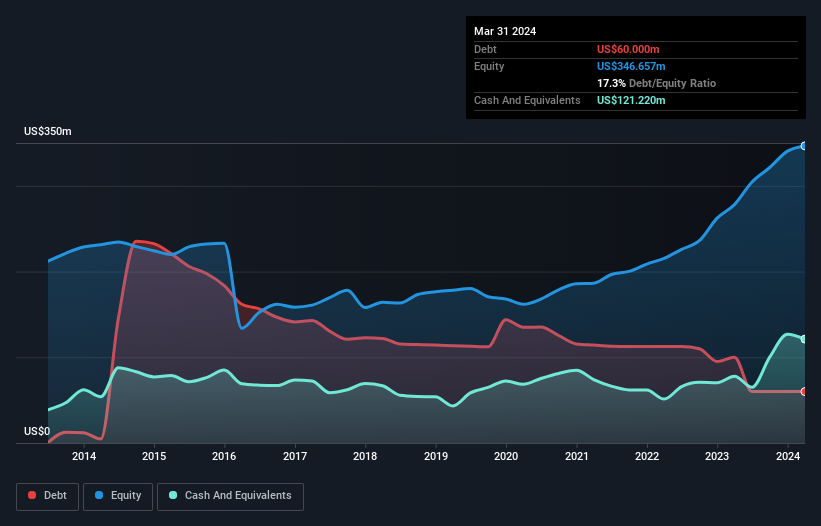- United States
- /
- Electronic Equipment and Components
- /
- NasdaqGS:BELF.A
We Think Bel Fuse (NASDAQ:BELF.A) Can Stay On Top Of Its Debt
Warren Buffett famously said, 'Volatility is far from synonymous with risk.' So it might be obvious that you need to consider debt, when you think about how risky any given stock is, because too much debt can sink a company. We note that Bel Fuse Inc. (NASDAQ:BELF.A) does have debt on its balance sheet. But the real question is whether this debt is making the company risky.
Why Does Debt Bring Risk?
Debt assists a business until the business has trouble paying it off, either with new capital or with free cash flow. In the worst case scenario, a company can go bankrupt if it cannot pay its creditors. However, a more common (but still painful) scenario is that it has to raise new equity capital at a low price, thus permanently diluting shareholders. Of course, the upside of debt is that it often represents cheap capital, especially when it replaces dilution in a company with the ability to reinvest at high rates of return. The first step when considering a company's debt levels is to consider its cash and debt together.
View our latest analysis for Bel Fuse
What Is Bel Fuse's Debt?
As you can see below, Bel Fuse had US$60.0m of debt at March 2024, down from US$100.0m a year prior. But on the other hand it also has US$121.2m in cash, leading to a US$61.2m net cash position.

How Strong Is Bel Fuse's Balance Sheet?
We can see from the most recent balance sheet that Bel Fuse had liabilities of US$86.5m falling due within a year, and liabilities of US$122.2m due beyond that. Offsetting this, it had US$121.2m in cash and US$92.6m in receivables that were due within 12 months. So it can boast US$5.15m more liquid assets than total liabilities.
Having regard to Bel Fuse's size, it seems that its liquid assets are well balanced with its total liabilities. So while it's hard to imagine that the US$866.2m company is struggling for cash, we still think it's worth monitoring its balance sheet. Simply put, the fact that Bel Fuse has more cash than debt is arguably a good indication that it can manage its debt safely.
Fortunately, Bel Fuse grew its EBIT by 3.7% in the last year, making that debt load look even more manageable. The balance sheet is clearly the area to focus on when you are analysing debt. But ultimately the future profitability of the business will decide if Bel Fuse can strengthen its balance sheet over time. So if you're focused on the future you can check out this free report showing analyst profit forecasts.
Finally, while the tax-man may adore accounting profits, lenders only accept cold hard cash. Bel Fuse may have net cash on the balance sheet, but it is still interesting to look at how well the business converts its earnings before interest and tax (EBIT) to free cash flow, because that will influence both its need for, and its capacity to manage debt. Over the most recent three years, Bel Fuse recorded free cash flow worth 60% of its EBIT, which is around normal, given free cash flow excludes interest and tax. This cold hard cash means it can reduce its debt when it wants to.
Summing Up
While we empathize with investors who find debt concerning, you should keep in mind that Bel Fuse has net cash of US$61.2m, as well as more liquid assets than liabilities. So we don't think Bel Fuse's use of debt is risky. The balance sheet is clearly the area to focus on when you are analysing debt. But ultimately, every company can contain risks that exist outside of the balance sheet. Case in point: We've spotted 1 warning sign for Bel Fuse you should be aware of.
If, after all that, you're more interested in a fast growing company with a rock-solid balance sheet, then check out our list of net cash growth stocks without delay.
Valuation is complex, but we're here to simplify it.
Discover if Bel Fuse might be undervalued or overvalued with our detailed analysis, featuring fair value estimates, potential risks, dividends, insider trades, and its financial condition.
Access Free AnalysisHave feedback on this article? Concerned about the content? Get in touch with us directly. Alternatively, email editorial-team (at) simplywallst.com.
This article by Simply Wall St is general in nature. We provide commentary based on historical data and analyst forecasts only using an unbiased methodology and our articles are not intended to be financial advice. It does not constitute a recommendation to buy or sell any stock, and does not take account of your objectives, or your financial situation. We aim to bring you long-term focused analysis driven by fundamental data. Note that our analysis may not factor in the latest price-sensitive company announcements or qualitative material. Simply Wall St has no position in any stocks mentioned.
About NasdaqGS:BELF.A
Bel Fuse
Designs, manufactures, markets, and sells products that power, protect, and connect electronic circuits.
Flawless balance sheet and undervalued.
Similar Companies
Market Insights
Community Narratives



